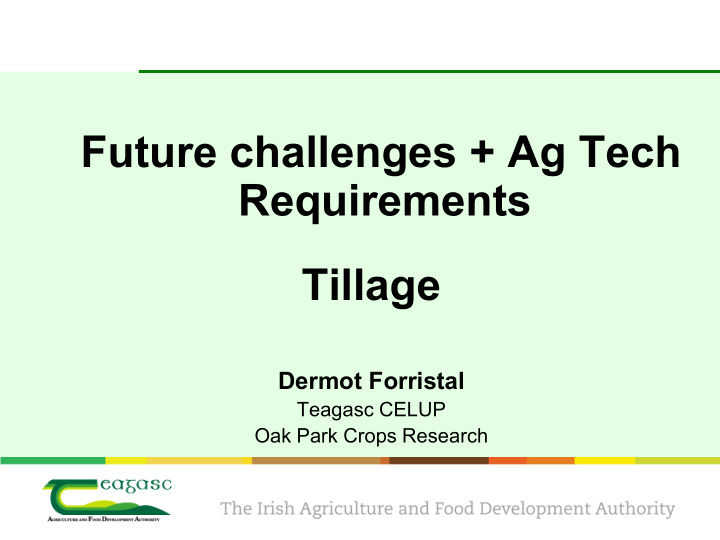



Future challenges + Ag Tech Requirements Tillage Dermot Forristal Teagasc CELUP Oak Park Crops Research
Challenges in the crops sector Competition for land Profitability per ha Disease, Pest and Weed control ▶ E.g. loss of fungicide sensitivity / less new products ▶ IPM and cultural control GHG emissions Positives ▶ World’s highest yields ▶ Labour efficient
Ag Tech Needs More precise management ‘Precise’ Management : Machine control Auto-steer measuring + responding to ‘variability’. Auto ‘section- control’ Any automated function Fields: Spatial variability
‘SMART’ Sensors Measure Data Collect data communications Analyse Research Algorithms Decision Controllers
Mesmerised by Yield Maps ! 7t / ha 10t / ha 10t / ha 14t / ha Initial Assumption • All could yield 14t • At least 10t ? Not That Simple! Huge expectations generated Blinded by ‘possibilities’
Advances in Precision Ag but!
Variable rate application: Nitrogen Applying N more accurately Huge scope as optimum varies hugely: 100 – 300 kg/ha Cost, quality and environmental consequences !
Crop Reflectance and N Measure crop biomass and N content – crop reflectance Reflectance scanner (multi-spec): ▶ Visible and NIR wave bands Quite a bit of research since the 1970s!!
Farmstar N sensing - France
Yara N Sensor
E bee drone with Sensor
Does crop sensing work for N ? BUT, Does it work? 1% or 3-4% yield improvement. Algorithms not region specific ▶ Some maximise protein ▶ Some optimise yield N is Not that simple What comes from the soil ? What is crop yield potential Weather and soil impact on both Need to measure and predict these What’s needed to improve it: soil sensors, leaching prediction, crop growth models etc all need development
Precision Crop management Soil sensing: Crop sensing: Environment • Nutrients • Nutrients sensing: • Organic Carbon • Development • Structure / texture • Microclimate • Health / disease • Weather prediction • Microbiome • Yield / Quality • Moisture • Variability Supporting Tech transfer Data analytics Research support Crop Models Decision Support Systems Precision management response (spatially variable, real time or sequential)
Machine Guidance, Autosteer and Control
Machine Guidance: Steering, Headland systems
97% full header vs 87% Not 10% performance improvement
Does it Pay? (Getting Farmers to Adopt!)
Auto - steer + Section Control
Sprayer section control (avoids excess overlaps)
Guidance and Section control Benefits: - depends on field 3m saving on headlands: 2.0% saving Saving on short ground: 0.5% No loss on tramlines: 4.0% Total saving 6.5% Fungicide / Herbicide saving Winter wheat: €16.00 / ha Spring Barley: €8.76 / ha
Guidance and sprayer control costs Break even areas W. wheat: 128 / 172ha S. barley: 230 / 315ha
Machine control (– does it pay?) Control systems on all machines Sprayers Fert spreaders Combines Seeders Slurry / Muck Diet feeders Ploughs Balers / Foragers Tractors Etc, etc
SMART can be simple and free ! Oilseed Rape N management
Oilseed rape: Canopy Management Optimises N – Saves N Optimises canopy size, pod number and yield. It Works: Why? Good relationship between accumulated N and required N Substantial research programme Simple to operate Free
Farm Management Applications
Farm management applications Around for decades. SMART phones breathing new life Management; Agronomy; Animal / Herd; Financial Regulatory compliance: Cattle ID; Farm health; Pesticides etc; Nitrates etc
Getting their hands on the Data!!
Farm data !!! Data from: ▶ Reflectance sensors: Sattelite, Drone, Tractor mounted ▶ Soil sensors: Electrical conductivity, Tractor draught ▶ Soil Analysis: nutrients, pH, Carbon ▶ Yield mapping combine ▶ Input application: seeder, sprayer, fertiliser, manures ▶ Weather data: field level or region based ▶ Disease data; crop growth etc ▶ Financial data from farm at farm or field level Who collects, transmits, stores, analyses and uses data?
Lots of players ! Tractor / equipment manufacturers: JD, CLAAS ‘Positioning’ companies: TRIMBLE; TOPCON Breeders / Chemical companies Traditional Farm management companies New Data management Hubs 365FARMNET
Conclusions Huge potential in crop systems and machines Concepts are there and good; but delivery challenging Seek simple opportunities For the user: the technology must pay . For the developer: the technology must pay!
Recommend
More recommend